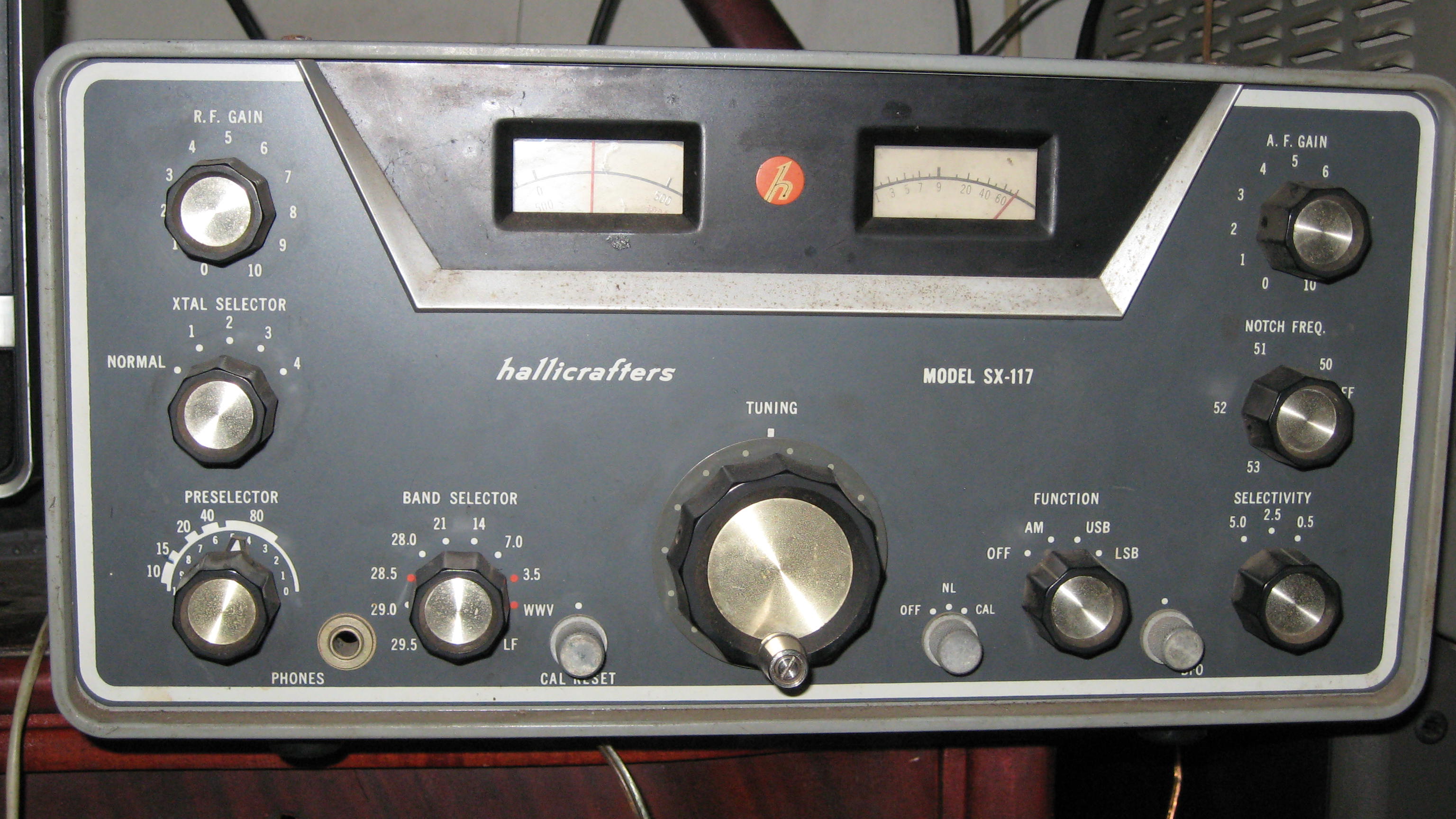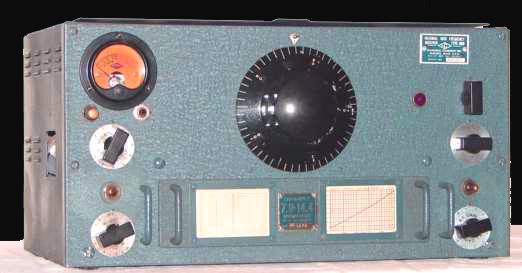|
Hallicrafters SX-117
The Hallicrafters SX-117 was a radio communications receiver manufactured by the Hallicrafters company in the 1960s. Description The SX-117 was a triple conversion intermediate frequency receiver designed to cover the 10 meter to 80 meter amateur radio bands with an additional band switch setting for WWV on 10 MHz. The first and third conversion oscillators were crystal-controlled. The second was variable from 6 to 6.5 MHz. Introduced in 1962 at a price of $379.95, it had a product detector for SSB, a notch filter, and selectable bandwidth of 0.5, 2.5, and 5 kHz. In addition to the ham bands, general coverage was possible for most frequencies in 500 kHz segments from 85 kHz to 30 MHz with appropriate crystals. For frequencies below 3 MHz, the HA-10 LF/MF converter was an optional accessory costing $24.95. The receiver featured 13 vacuum tubes plus solid state rectifiers and a noise limiter. Specifications *Input Voltage: 105-125 VAC 50/60 Hz. *Po ... [...More Info...] [...Related Items...] OR: [Wikipedia] [Google] [Baidu] |
Radio
Radio is the technology of signaling and communicating using radio waves. Radio waves are electromagnetic waves of frequency between 30 hertz (Hz) and 300 gigahertz (GHz). They are generated by an electronic device called a transmitter connected to an antenna which radiates the waves, and received by another antenna connected to a radio receiver. Radio is very widely used in modern technology, in radio communication, radar, radio navigation, remote control, remote sensing, and other applications. In radio communication, used in radio and television broadcasting, cell phones, two-way radios, wireless networking, and satellite communication, among numerous other uses, radio waves are used to carry information across space from a transmitter to a receiver, by modulating the radio signal (impressing an information signal on the radio wave by varying some aspect of the wave) in the transmitter. In radar, used to locate and track objects like aircraft, ships, spacecraf ... [...More Info...] [...Related Items...] OR: [Wikipedia] [Google] [Baidu] |
Communications Receiver
A communications receiver is a type of radio receiver used as a component of a radio communication link. This is in contrast to a ''broadcast receiver'' which is used to receive radio broadcasts. A communication receiver receives parts of the radio spectrum not used for broadcasting, that includes amateur, military, aircraft, marine, and other bands. They are often used with a radio transmitter as part of a two-way radio link for shortwave radio or amateur radio communication, although they are also used for shortwave listening. Features Commercial communications receivers are characterized by high stability and reliability of performance, and are generally adapted for remote control and monitoring. For marketing purposes, many hobby-type receivers are advertised as "communications receivers" although none are suited for heavy-duty, reliable 24-hour use as the primary form of communication for an isolated station. Typically, a communications receiver is of the superheterody ... [...More Info...] [...Related Items...] OR: [Wikipedia] [Google] [Baidu] |
Hallicrafters
The Hallicrafters Company manufactured, marketed, and sold radio equipment, and to a lesser extent televisions and phonographs, beginning in 1932. The company was founded by William J. Halligan and based in Chicago, Illinois, United States. In 1966 Halligan sold the company to the Northrop Corporation and Halligan family involvement ended. Northrop ran the company until the early 1970s, but by this time, fierce Japanese competition was putting pressure on the US domestic electronics market. Northrop sold the company name (but kept the factory, by then located in Rolling Meadows, a Chicago suburb) in 1975, bringing non-military electronics production to an end, and turning the plant into Northrop Corporation's Defense Systems Division. History William J. Halligan (1898–1992), founded Hallicrafters Company in Chicago in late 1932. Prior to this, he had been involved in radio parts sales for some years but decided the time was right for a handcrafted amateur radio receiver - ... [...More Info...] [...Related Items...] OR: [Wikipedia] [Google] [Baidu] |
Intermediate Frequency
In communications and electronic engineering, an intermediate frequency (IF) is a frequency to which a carrier wave is shifted as an intermediate step in transmission or reception. The intermediate frequency is created by mixing the carrier signal with a local oscillator signal in a process called heterodyning, resulting in a signal at the difference or beat frequency. Intermediate frequencies are used in superheterodyne radio receivers, in which an incoming signal is shifted to an IF for amplification before final detection is done. Conversion to an intermediate frequency is useful for several reasons. When several stages of filters are used, they can all be set to a fixed frequency, which makes them easier to build and to tune. Lower frequency transistors generally have higher gains so fewer stages are required. It's easier to make sharply selective filters at lower fixed frequencies. There may be several such stages of intermediate frequency in a superheterodyne receiver; t ... [...More Info...] [...Related Items...] OR: [Wikipedia] [Google] [Baidu] |
10 Meter Band
The 10-meter band is a portion of the shortwave radio spectrum internationally allocated to amateur radio and amateur satellite use on a primary basis. The band consists of frequencies stretching from 28.000 to 29.700 MHz. History The 10-meter band was allocated on a worldwide basis by the International Radiotelegraph Conference in Washington, D.C., on October 4, 1927. Its frequency allocation was then 28-30 MHz. A 300 kHz segment, from 29.700 MHz to 30.000 MHz, was removed from the amateur radio allocation by the 1947 International Radio Conference of Atlantic City. In the late 1970s, the impending ban by the FCC of the sale of older 23-channel CB equipment that did not meet more stringent restrictions on newer, 40-channel units, meant that a surplus of 23-channel CB gear was on the market. This was a windfall for amateur radio enthusiasts, allowing access to fairly inexpensive radios which could easily be modified for use in the 10-meter band. A ... [...More Info...] [...Related Items...] OR: [Wikipedia] [Google] [Baidu] |
80 Meter Band
The 80-meter or 3.5 MHz band is a band of radio frequencies allocated for amateur radio use, from 3.5 to 4.0 MHz in IARU Region 2 (consisting mostly of North and South America), and generally 3.5 to 3.8 or 3.9 MHz in Regions 1 and 3 (the rest of the world) respectively. The upper portion of the band, which is usually used for phone (voice), is sometimes referred to as 75 meters. In Europe, 75m is a shortwave broadcast band, with a number of national radio services operating between 3.9 and 4.0 MHz. Because of high D layer absorption that persists until sunset, 80 meters is usually only good for local communications during the day, and hardly ever good for communications over intercontinental distances during the day. But it is the most popular band for regional communications networks from the late afternoon through the night time hours. At night, "80" is usually reliable for short to medium distance contacts, with average distances ranging from local contacts ... [...More Info...] [...Related Items...] OR: [Wikipedia] [Google] [Baidu] |
Amateur Radio
Amateur radio, also known as ham radio, is the use of the radio frequency spectrum for purposes of non-commercial exchange of messages, wireless experimentation, self-training, private recreation, radiosport, contesting, and emergency communications. The term "amateur" is used to specify "a duly authorised person interested in radioelectric practice with a purely personal aim and without pecuniary interest;" (either direct monetary or other similar reward) and to differentiate it from commercial broadcasting, public safety (such as police and fire), or professional two-way radio services (such as maritime, aviation, taxis, etc.). The amateur radio service (''amateur service'' and '' amateur-satellite service'') is established by the International Telecommunication Union (ITU) through the Radio Regulations. National governments regulate technical and operational characteristics of transmissions and issue individual station licenses with a unique identifying call sign, which mus ... [...More Info...] [...Related Items...] OR: [Wikipedia] [Google] [Baidu] |
WWV (radio Station)
WWV is a shortwave ("high frequency" or HF) radio station, located near Fort Collins, Colorado. It has broadcast a continuous time signal since 1945, and implements United States government frequency standards, with transmitters operating on 2.5, 5, 10, 15, and 20 MHz. WWV is operated by the U.S. National Institute of Standards and Technology (NIST), under the oversight of its Time and Frequency Division, which is part of NIST's Physical Measurement Laboratory based in Gaithersburg, Maryland. WWV was established in 1919 by the Bureau of Standards in Washington, D.C., making it one of the oldest continuously-operating radio stations in the United States. NIST celebrated WWV's centennial on October 1, 2019. In 1931, the station relocated to the first of three suburban Maryland sites, before moving to a location near Fort Collins in 1966. WWV shares this site with longwave (also known as "low frequency" or LF) station WWVB, which transmits carrier and time code (no voice) at 60 ... [...More Info...] [...Related Items...] OR: [Wikipedia] [Google] [Baidu] |
Single-sideband Modulation
In radio communications, single-sideband modulation (SSB) or single-sideband suppressed-carrier modulation (SSB-SC) is a type of modulation used to transmit information, such as an audio signal, by radio waves. A refinement of amplitude modulation, it uses transmitter power and bandwidth more efficiently. Amplitude modulation produces an output signal the bandwidth of which is twice the maximum frequency of the original baseband signal. Single-sideband modulation avoids this bandwidth increase, and the power wasted on a carrier, at the cost of increased device complexity and more difficult tuning at the receiver. Basic concept Radio transmitters work by mixing a radio frequency (RF) signal of a specific frequency, the carrier wave, with the audio signal to be broadcast. In AM transmitters this mixing usually takes place in the final RF amplifier (high level modulation). It is less common and much less efficient to do the mixing at low power and then amplify it in a linear ampl ... [...More Info...] [...Related Items...] OR: [Wikipedia] [Google] [Baidu] |
Vacuum Tube
A vacuum tube, electron tube, valve (British usage), or tube (North America), is a device that controls electric current flow in a high vacuum between electrodes to which an electric voltage, potential difference has been applied. The type known as a thermionic tube or thermionic valve utilizes thermionic emission of electrons from a hot cathode for fundamental electronic functions such as signal amplifier, amplification and current rectifier, rectification. Non-thermionic types such as a vacuum phototube, however, achieve electron emission through the photoelectric effect, and are used for such purposes as the detection of light intensities. In both types, the electrons are accelerated from the cathode to the anode by the electric field in the tube. The simplest vacuum tube, the diode (i.e. Fleming valve), invented in 1904 by John Ambrose Fleming, contains only a heated electron-emitting cathode and an anode. Electrons can only flow in one direction through the device—fro ... [...More Info...] [...Related Items...] OR: [Wikipedia] [Google] [Baidu] |
Solid State (electronics)
Solid-state electronics means semiconductor electronics: electronic equipment using semiconductor devices such as transistors, diodes and integrated circuits (ICs). The term is also used as an adjective for devices in which semiconductor electronics that have no moving parts replace devices with moving parts, such as the solid-state relay in which transistor switches are used in place of a moving-arm electromechanical relay, or the solid-state drive (SSD) a type of semiconductor memory used in computers to replace hard disk drives, which store data on a rotating disk. History The term "solid-state" became popular at the beginning of the semiconductor era in the 1960s to distinguish this new technology based on the transistor, in which the electronic action of devices occurred in a solid state, from previous electronic equipment that used vacuum tubes, in which the electronic action occurred in a gaseous state. A semiconductor device works by controlling an electric current c ... [...More Info...] [...Related Items...] OR: [Wikipedia] [Google] [Baidu] |





.jpg)

